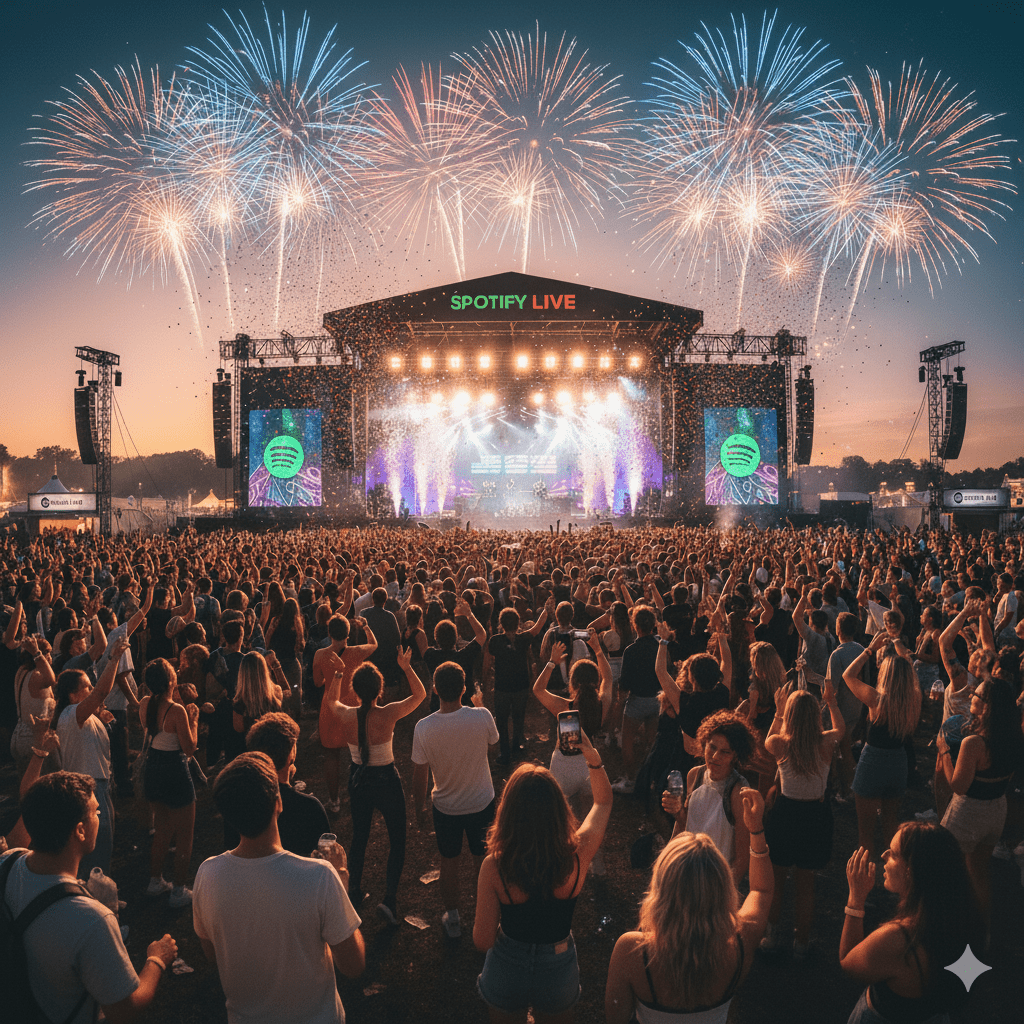From Headphones to Front Row
It all began in private—headphones, playlists, algorithmic recommendations. Yet music has always craved an audience. The History of Live Streaming shows how technology slowly erased the line between online and stage. By the time Spotify ruled the soundscape, fans wanted more than a playlist—they wanted presence.
Contrary to fear, streaming didn’t kill concerts. Research from Christensen’s 2022 study found that streaming actually boosted live attendance. The more people listened online, the more they craved the real thing.
How the Spotify Music Festival Took Shape
Spotify had data—billions of streams mapping taste by zip code. Turning that data into a festival was inevitable. Fans already built imaginary lineups through playlists; the company simply gave those playlists a stage. According to Spotify Ads & Insights, listener engagement spikes during festival season, proof that fans think of streaming and live music as one rhythm.
Each performance became a physical playlist. Each crowd, a social network come alive. This is the moment the algorithm learned to dance.
The Perfect Cultural Storm
Technology matured just as culture hungered for authenticity. The 2017 Naveed paper called it the birth of the “Live-Concert-Streaming Industry.” Spotify’s model fit perfectly—bridging digital convenience and analog emotion.
Rolling Stone later reported on Spotify’s move to support venues directly in NSW, Australia, cementing its role as patron, not just platform. When tech starts paying for stages, culture shifts fast.
The Anatomy of a Spotify Music Festival
Picture this: you arrive at a field glowing green, the Spotify logo refracted through drone lights. Artists are chosen from global streaming data, each representing a sound trend. The schedule syncs with your app. Your wristband unlocks custom playlists and live video feeds.
Every element of the Spotify Music Festival feels personalized—because it literally is. Behind every setlist is an algorithm tuned to listener passion.
From Streamer to Superfan
Data creates discovery; live moments create memory. Studies like Arxiv’s analysis on concert contagion show that attending a show spikes streaming for weeks afterward. It’s a feedback loop: stream, attend, relive, repeat.
The Spotify Music Festival makes this loop visceral. It transforms analytics into applause.
Brand Power and the Business of Belonging
For sponsors, these festivals are data-driven dreamscapes. They merge storytelling, audience insight, and prestige. The logic mirrors luxury-brand strategy—curate exclusivity, amplify emotion, and connect people through shared status.
At Social Life Magazine, we’ve seen the same effect in the Hamptons: brands thrive when they stop advertising and start hosting. Spotify just scaled that idea to a global stage.
Challenges Along the Way
Some artists argue that streaming devalues their work. Others fear platform-owned festivals risk sanitizing music culture. Essays like “The Hidden Cost of Streaming” warn that discovery shouldn’t be dictated by data alone. But culture has always evolved through tension. Every revolution disrupts its own purity.
The challenge for Spotify is to keep it human—to make sure the math still moves hearts.
Evidence That It Works
Streaming and live events are now symbiotic. According to ResearchGate’s Eventization of Music study, streams of artists performing at festivals surge by over 40% during event weeks. The festival becomes an accelerant, feeding both sides of the industry.
Spotify’s edge is precision. It doesn’t guess trends—it creates them in real time.
The Future: Hybrid Worlds
Tomorrow’s festivals will blur even further. Expect augmented reality stages, immersive second-screen experiences, and AI-generated setlists responding to crowd energy. The Spotify Music Festival is just the first major proof of concept.
What started as a playlist may end as a full-fledged universe. And that’s the magic—music finding new ways to bring us together, one stream, one song, one crowd at a time.
Final Encore: The Human Connection
At its heart, the Spotify Music Festival is about belonging. It’s the sound of data learning to feel. It’s the hum of thousands singing the same lyrics they once played alone at 2 a.m.
Streaming built the audience. Live music gave it a soul. Together, they created the movement.
